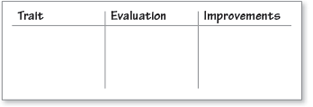Creative-Thinking Activities
The activities below and on the next page will help you practice your creative- thinking skills.
Developing a Creative Mindset
Creative thinking requires a certain mindset characterized by these qualities:
- Curiosity: Open yourself to possibilities. Wonder about your world, about how things work and what is going on.
- Passion: Pursue what you love. Seek it unapologetically. Make choices to develop ideas unique to your interests.
- Productivity: Create in quantity. Make more than you need and select the best to pass along.
- Courage: Overcome obstacles. Work persistently. Take time away when you need to, but then come back.
Your Turn Rate yourself for each of the parts of a creative mindset. Then consider one thing you could do to improve each rating.

Abundance and Novelty
Creative thinking does not focus on one answer, but on many answers. It doesn’t focus on the right answer, but on unique answers. Creative thinking produces many new ideas, and the following activities will help you create some of your own.
Your Turn Rock on. List as many original uses for a rock as you can. Go beyond building materials, paperweights, and bookends. Afterward, compare your list with a classmate’s. Cross out any common answers. How many unique ideas did the two of you devise?
Use it or lose it. Select an object you are currently using or studying. Write as many original uses for the object as you can think of. Compare your list with a classmate’s, crossing out common answers. How many unique ideas did the two of you devise?
Corporate clip climber. Imagine that you want to land your dream job and must use a paperclip to do so. Write as many ways as possible to use the paperclip to land this job.
Tiny turning points. Choose one of the classes you are taking now. Within that subject, think of the smallest object that has made the biggest difference (for example, in American history, the pen that signed the Emancipation Proclamation). Make a class list of original answers.
Alarming Innovation
Creative thinking makes unusual connections and uses materials in new ways. Creativity is key to innovation. The following activity will help you innovate.
Your Turn Imagine that you want to create an alarm system to let you know if someone walks past your desk. Look at the things on the desk or table in front of you. Use these things (paper, pens, books, etc.) in a creative way to make an alarm system that will alert you if someone walks past your desk. Compare your solution with another student’s.
What’s the Value?
Creative thinking helps you discover possibilities for improving or changing things that you had taken for granted. This activity will help you find new possibilities.

Your Turn Take a seat. Consider the chair or bench you are sitting on. What is good about it? What is not so good? Do a trait evaluation of the seat, listing its attributes in the first column, evaluating each attribute in the second column, and writing improvements in the third column. Use a chart like the one here.
Your Turn Evaluate a subject. Select a person, place, thing, or idea you have been learning about. Do a trait evaluation of this topic.
Manipulative Creativity
Creativity can transform a topic. It considers not only what the topic is, but also what it could become. Manipulative verbs help you to create such transformations.
accelerate
accessorize
amplify
automate
bend
brand
break
elevate
freeze
decelerate
deflate
divide
inflate
melt
multiply
reverse
shrink
simplify
stretch
twist
Your Turn Seat strategies. Select one of the manipulative verbs above and apply it to the chair or bench you are sitting on. List as many transformations as you can imagine.
Subject strategies. Select a person, place, thing, or idea you have been studying. Apply one of the manipulative verbs to your selection, and list as many transformations as you can imagine.
